Farming just outside Newton Cunnighnam in east Co Donegal, Jamie Rankin is passionate about growing crops and is a well-known potato grower. He grows a variety of crops alongside his potatoes, including barley, oats, wheat and oilseed rape, on over 600 acres, the majority of which is on leased land.
Jamie grows crops on some hilly terrain and, as a result, the land type plays a pivotal role in machine selection, with all gear bought to suit. Jamie took delivery of the new Horsch front- and rear-mounted sprayer tank combination over one year ago, and was the first to buy this particular model in Ireland. We caught up with him to see how it has performed to date.
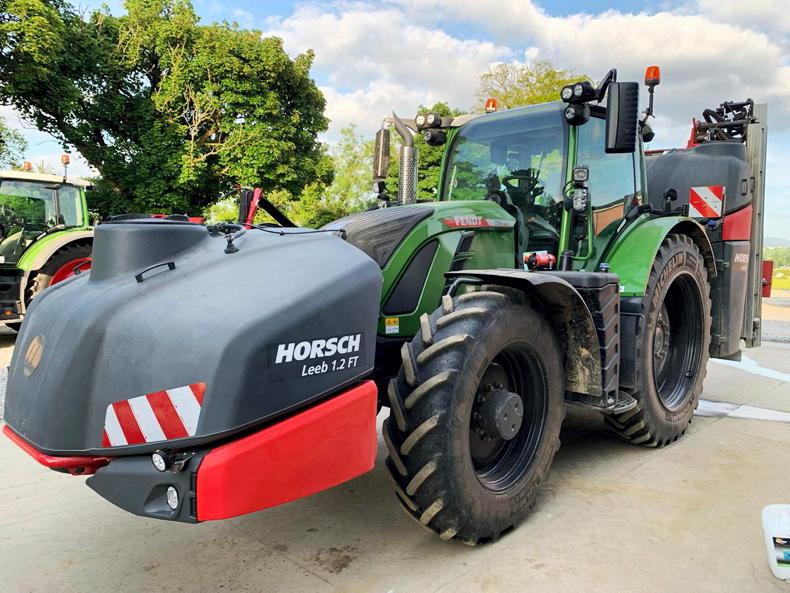
The operator can set to empty the front to rear tanks in equal proportion for optimum weight distribution.
A history steeped in sprayers
“I bought my first sprayer in the mid 1990s. It was a 15m mounted Allman sprayer, which I operated on a Fiat 80-90. In 2000, I moved to my first self-propelled sprayer. This was a second-hand Chaviot sprayer. It had two centrifugal pumps and in many ways was a brilliant machine. It had a Land Rover engine and a LDV minivan gearbox. It was well weighted; all controls were on a joystick and it was fit to climb any hill. The sprayer was ahead of its time, but the gearbox was a big problem. I learned more about mechanics with that gearbox than any other piece of machinery I’ve ever had.
“We updated to our first Agribuggy in 2005. This was one of the first 2,500l models. It was a brilliant sprayer to suit our farm. Its only weak point was the Land Rover engine, it had a soft head gasket. In 2011 we bought a new 2,500l Agribuggy. This was the first model with a Cummins engine, and also got a new cab and an upgraded gearbox. The gearbox was a great addition, but it had some stupid issues, which were based on some of the modifications they made from the previous sprayer. The cab had very limited visibility.
“We bought another new Agribuggy in 2017. This was an A280, which was another 2,500l unit, with 24m booms. It was a good machine, but they tried to add electronics to an old gearbox, which didn’t work very well. The brakes were too exposed for potato ground and this caused problems. This was around the same time that the Alamo Group (McConnel parent company) bought Agribuggy, and I think they rushed the model to the market.
“In 2021, we looked at buying a new SAM or Bateman self-propelled sprayer. We opted for a 3,000l SAM on 28m booms. We kept it for six months, but it wasn’t gutsy enough for our terrain. We went back to SAM and told them the problem, and they sent over two engineers. They designed a 3,000l sprayer on a 4,000l sprayer chassis, on a larger horsepower engine. The tank was positioned forward on the chassis, which gave it way more traction. This was an absolute dream of a machine.
“In March of last year, we had a very bad fire in our yard and we lost almost our full fleet of machinery, including the then 18-month-old sprayer. We went back to SAM about replacing the sprayer, but we would have to wait until August for a new machine. We looked at buying another Agribuggy, an Amazone and a Horsch sprayer. In the end, we opted for the new Horsch set up based on its cleaning system and boom control system.”
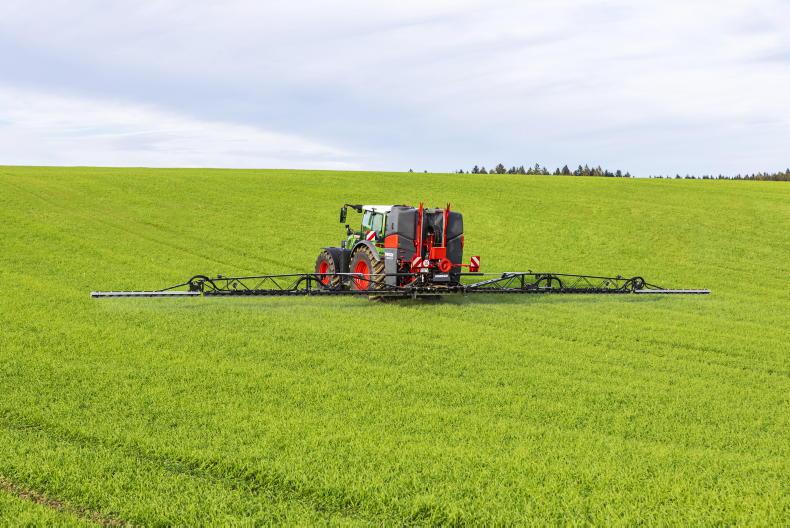
“The boom levelling system works a dream, it’s the best I’ve ever seen".
Horsch sprayer
Jamie opted for a Horsch Leeb CS 1.8 and an FT 1.2. Essentially, this is an 1,800l rear tank and a 1,200l front tank combination, offering a total nominal volume of 3,000l. Different boom types are available, ranging from 15-30m. Jamie’s machine is equipped with 24m booms, which is fitted with 14 sections. The front tank is automatically managed by the rear tank. This includes filling, agitation, washing out, emptying and homogenisation of the chemical mix. The operator can set to empty the front to rear tanks in equal proportion for optimum weight distribution.
Boom
Jamie opted for the 24m booms, but said if buying again he would go to 28m booms. Horsch booms use its well-proven parallelogram suspension and boom control system, which is designed to work at high operational speeds. The manufacturer says its suspension with active control of the middle section prevents immersion during cornering and on headlands. Aluminium profiles protect nozzles, nozzle bodies and spray lines. Horsch’s ‘Boom Control Pro’ is an automatic boom control system to maintain the lowest possible working height at high operational speeds. The control system has a target height of under 40cm above the crop, to ensure minimum drift. The boom is completely independent from the machine. It caters for independent angling of the boom section and the middle section to follow the terrain. The boom adapts to the terrain through the use of six ultrasonic sensors that actively follow the ground contours. On the road, the sprayer neatly folds to a transport width of 2.48m.
“The boom levelling system works a dream, it’s the best I’ve ever seen. It runs perfectly above the crop canopy. We work in a lot of small fields and hilly ground, and it doesn’t blink an eyelid at it,” noted Jamie.
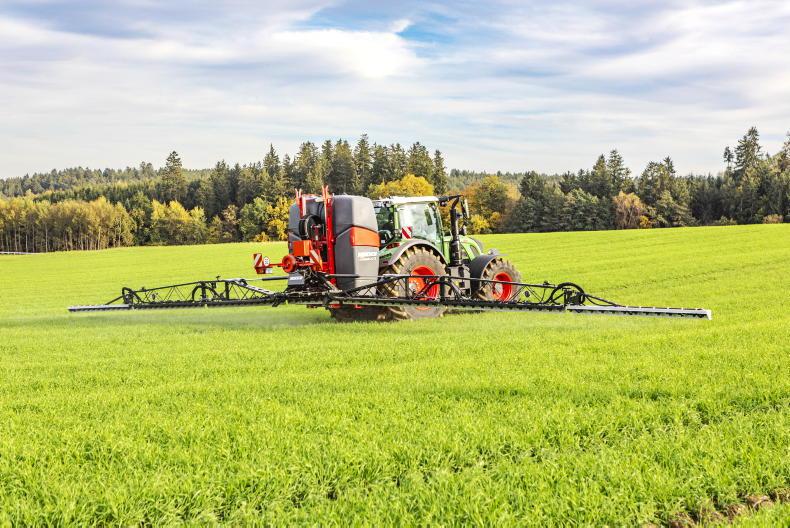
Jamie opted for the 24m booms, but said if buying again he would go to 28m booms.
Mixing and cleaning
All functions from switching between filling, agitation, spraying, diluting, priming, rinsing and tank cleaning can be controlled from the cab and through an external terminal on the sprayer. To fill the tanks, a rotary pump with load-sensing is used, with electric operation for the suction and pressure side. It features an electronic level indicator at the mixture tank with automatic switch-off.
Horsch sprayers are known for its thorough cleaning system. The manufacturer calls it ‘Continuous Cleaning System Pro’ (CCS Pro), and it offers a quick cleaning process of the sprayer from the cab. Horsch says the water system guarantees a continuous inside cleaning of tank, lines and boom. The additional CCS piston diaphragm pump for cleaning pumps clean water into the spray lines, and the spraying pump removes the residual mixture from the nozzles and the spray lines instead of diluting it. This allows the system to be cleaned thoroughly and with little water.
The sprayer also features fully automatic nozzle changing on the go (auto select) and is capable of adjusting the application rate and the operational speed on the move.
“The cleaning system is fantastic. It cleans through displacement, where other sprayers clean by dilution. It’s very thorough, and the operator literally doesn’t have to do anything. The way I’ll describe it, a normal sprayer is like filling a bath and then you’ve to try flush out the tank. The Horsch sprayer is more like having a shower. One pump washes the tank with clean water from the top, and the other pump takes away the dirty water at the bottom and flushes it out through the nozzles. It’s a super system, there is no residue left behind,” said Jamie.
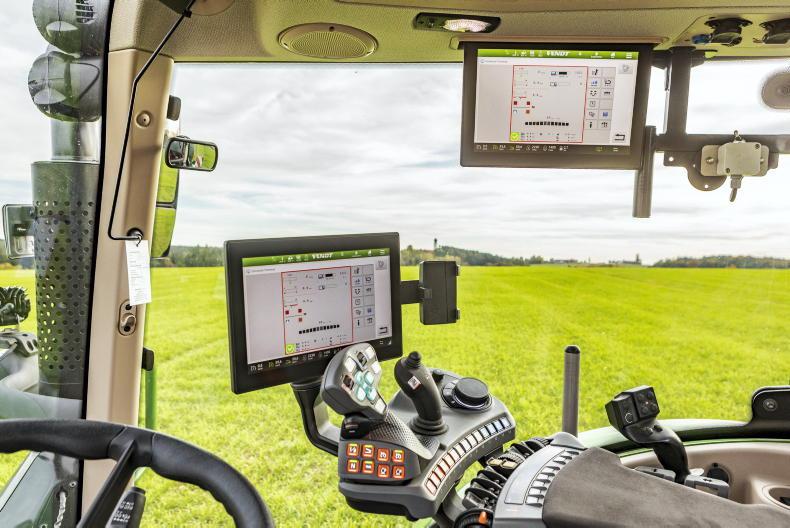
Jamie runs the sprayer on a Gen 6 Fendt 724- alongside the main control terminal, he also has a second display screen in the cab.
Controls
The unit comes with the option of a Muller control terminal, but Jamie opted for full IsoBus control. Jamie runs the sprayer on a Gen 6 Fendt 724. Alongside the main control terminal, he also has a second display screen in the cab. He uses one to display all machine settings, and the other to display the GPS guidance. Through the tractor’s screens, he can alter the machine settings and monitor the automatic section control.
“The sprayer is a brilliant fit with the Fendt. I have all our fields and tramlines saved on the tractor for planting, etc, and once I enter the field with the sprayer, they all appear on the screen. We run full RTK guidance, which means spraying with this combination is a breeze”.
Both the front and rear units are attached via an A-frame, while the sprayer sits on a trolley, so its easily moved. The machine is hydraulically driven and Jamie explained that one man would attach both the front and rear units in about five minutes.
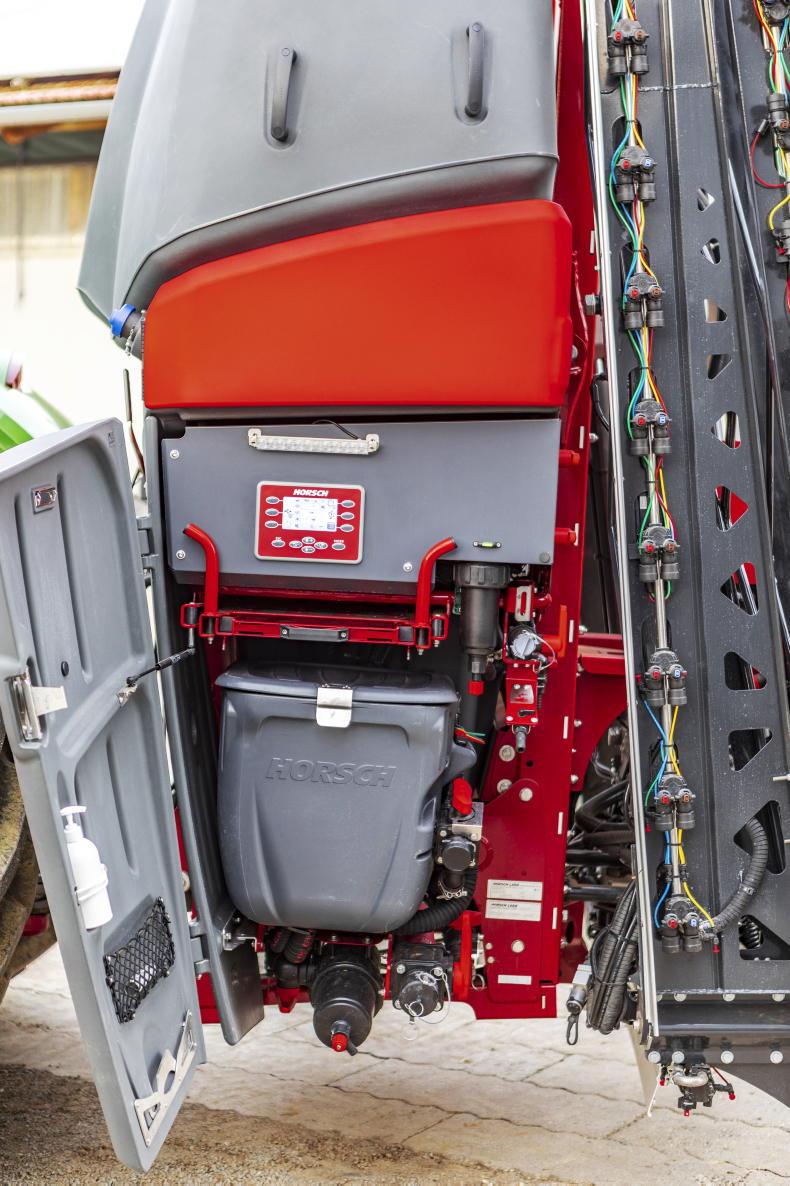
To fill the tanks, a rotary pump with load sensing is used with manual operation for the suction and pressure side.
Verdict
With 12 months experience under his belt, Jamie is extremely impressed with the sprayer.
“We’ve had occasional niggles with the sprayer, but there was never a day it failed to spray for us. The few issues we’ve had have been software, and Kelly’s always got us going in jig time. The accuracy of application, its thorough cleaning system and the boom control are unbelievable, I’ve never seen anything like it. On a wet year like last year, it’s hard to beat a self-propelled. However, the tractor-mounted combo worked really well. Each system has pros and cons. We work in an 18-mile radius, and it’s so hard to beat the comfort of a tractor vs a self-propelled sprayer. Going forward, we are considering running a used self-propelled such as an Agribuggy alongside the Horsch outfit. To be honest, we initially bought the Horsch sprayer as a stop gap, with the aim of going back to a self-propelled. But the machine has really changed my mind. Yes, in time we might run a self-propelled machine alongside for local work, but I have no intention of moving away from the Horsch mounted sprayer in the foreseeable future,” concluded Jamie.
Model: Horsch Leeb CS 1.8 and an FT 1.2.Weight: rear tank 1,500-2,050kg.Weight: front tank 223kg.Boom width: 24m booms.Nominal tank capacity: rear 1,800l, front 1,200l.Clean water tank: 400l.Hand wash tank: 15l.Chemical induction hopper:35l.Pump capacity:400l/min.Front tank price: €9,500,plus VAT.Rear unit starting price: €89,000, plus VAT.Likes
Boom levelling.Cleaning system.Easy to put on and take off (five minutes total).The IsoBus control setup.Dislikes
Rear unit is heavy on tractor’s back tyres.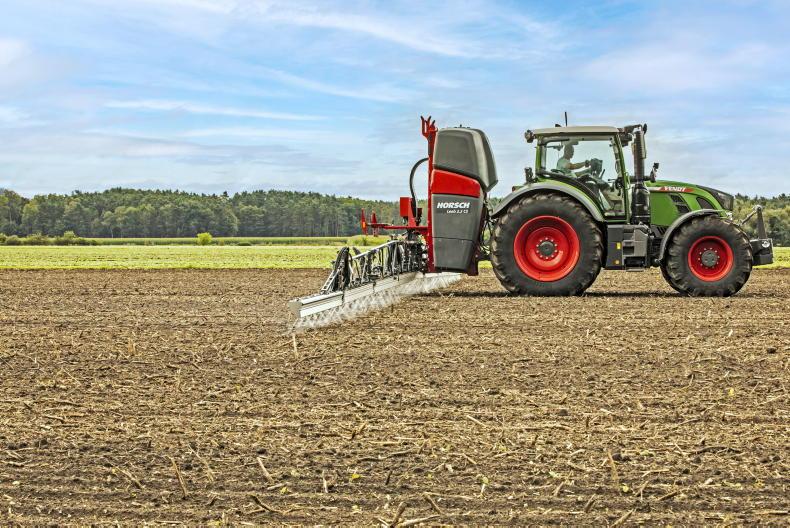
The boom adapts to the terrain through the use of four ultrasonic sensors that actively follow the ground contours.
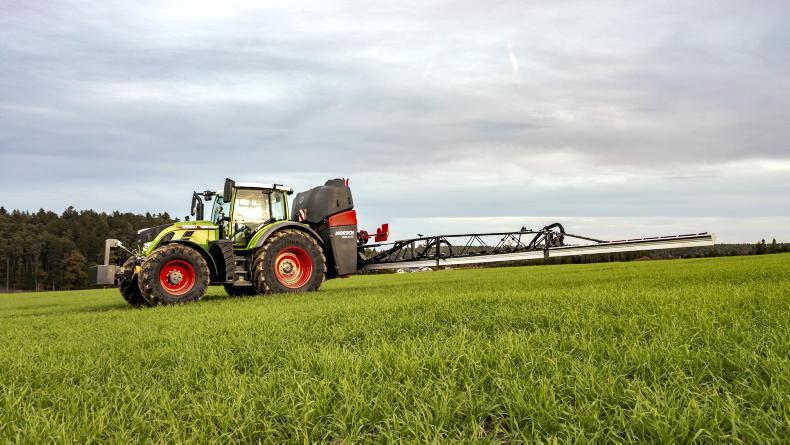
The sprayer features fully automatic nozzle changing on the go.
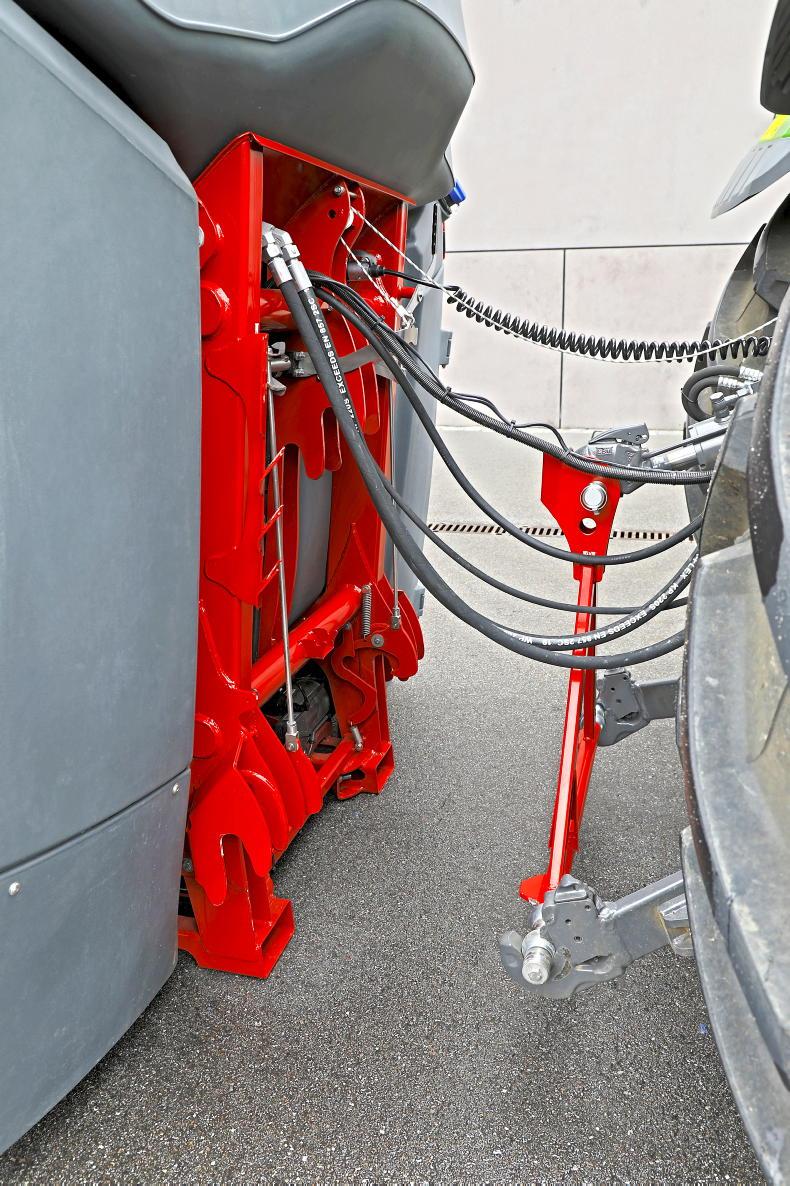
Both the front and rear units are attached via an A-frame, while the sprayer sits on a trolley, so its easily moved.
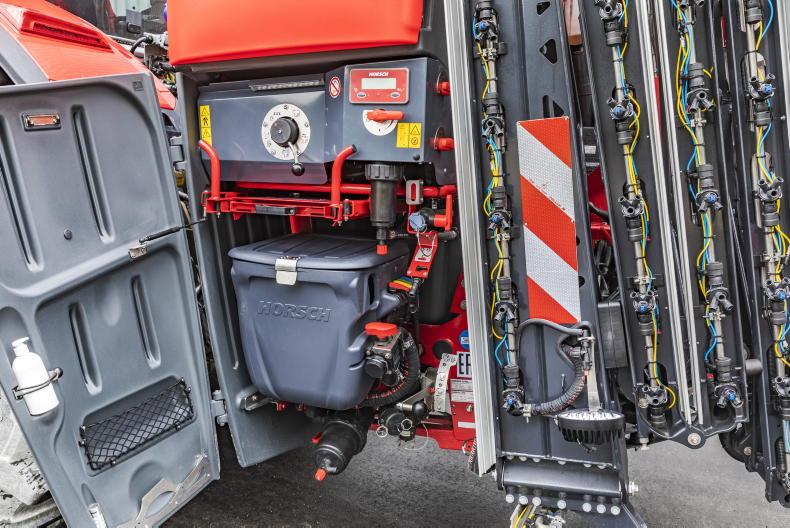
"The accuracy of application, its thorough cleaning system and the boom control are unbelievable, I’ve never seen anything like it".
Farming just outside Newton Cunnighnam in east Co Donegal, Jamie Rankin is passionate about growing crops and is a well-known potato grower. He grows a variety of crops alongside his potatoes, including barley, oats, wheat and oilseed rape, on over 600 acres, the majority of which is on leased land.
Jamie grows crops on some hilly terrain and, as a result, the land type plays a pivotal role in machine selection, with all gear bought to suit. Jamie took delivery of the new Horsch front- and rear-mounted sprayer tank combination over one year ago, and was the first to buy this particular model in Ireland. We caught up with him to see how it has performed to date.

The operator can set to empty the front to rear tanks in equal proportion for optimum weight distribution.
A history steeped in sprayers
“I bought my first sprayer in the mid 1990s. It was a 15m mounted Allman sprayer, which I operated on a Fiat 80-90. In 2000, I moved to my first self-propelled sprayer. This was a second-hand Chaviot sprayer. It had two centrifugal pumps and in many ways was a brilliant machine. It had a Land Rover engine and a LDV minivan gearbox. It was well weighted; all controls were on a joystick and it was fit to climb any hill. The sprayer was ahead of its time, but the gearbox was a big problem. I learned more about mechanics with that gearbox than any other piece of machinery I’ve ever had.
“We updated to our first Agribuggy in 2005. This was one of the first 2,500l models. It was a brilliant sprayer to suit our farm. Its only weak point was the Land Rover engine, it had a soft head gasket. In 2011 we bought a new 2,500l Agribuggy. This was the first model with a Cummins engine, and also got a new cab and an upgraded gearbox. The gearbox was a great addition, but it had some stupid issues, which were based on some of the modifications they made from the previous sprayer. The cab had very limited visibility.
“We bought another new Agribuggy in 2017. This was an A280, which was another 2,500l unit, with 24m booms. It was a good machine, but they tried to add electronics to an old gearbox, which didn’t work very well. The brakes were too exposed for potato ground and this caused problems. This was around the same time that the Alamo Group (McConnel parent company) bought Agribuggy, and I think they rushed the model to the market.
“In 2021, we looked at buying a new SAM or Bateman self-propelled sprayer. We opted for a 3,000l SAM on 28m booms. We kept it for six months, but it wasn’t gutsy enough for our terrain. We went back to SAM and told them the problem, and they sent over two engineers. They designed a 3,000l sprayer on a 4,000l sprayer chassis, on a larger horsepower engine. The tank was positioned forward on the chassis, which gave it way more traction. This was an absolute dream of a machine.
“In March of last year, we had a very bad fire in our yard and we lost almost our full fleet of machinery, including the then 18-month-old sprayer. We went back to SAM about replacing the sprayer, but we would have to wait until August for a new machine. We looked at buying another Agribuggy, an Amazone and a Horsch sprayer. In the end, we opted for the new Horsch set up based on its cleaning system and boom control system.”

“The boom levelling system works a dream, it’s the best I’ve ever seen".
Horsch sprayer
Jamie opted for a Horsch Leeb CS 1.8 and an FT 1.2. Essentially, this is an 1,800l rear tank and a 1,200l front tank combination, offering a total nominal volume of 3,000l. Different boom types are available, ranging from 15-30m. Jamie’s machine is equipped with 24m booms, which is fitted with 14 sections. The front tank is automatically managed by the rear tank. This includes filling, agitation, washing out, emptying and homogenisation of the chemical mix. The operator can set to empty the front to rear tanks in equal proportion for optimum weight distribution.
Boom
Jamie opted for the 24m booms, but said if buying again he would go to 28m booms. Horsch booms use its well-proven parallelogram suspension and boom control system, which is designed to work at high operational speeds. The manufacturer says its suspension with active control of the middle section prevents immersion during cornering and on headlands. Aluminium profiles protect nozzles, nozzle bodies and spray lines. Horsch’s ‘Boom Control Pro’ is an automatic boom control system to maintain the lowest possible working height at high operational speeds. The control system has a target height of under 40cm above the crop, to ensure minimum drift. The boom is completely independent from the machine. It caters for independent angling of the boom section and the middle section to follow the terrain. The boom adapts to the terrain through the use of six ultrasonic sensors that actively follow the ground contours. On the road, the sprayer neatly folds to a transport width of 2.48m.
“The boom levelling system works a dream, it’s the best I’ve ever seen. It runs perfectly above the crop canopy. We work in a lot of small fields and hilly ground, and it doesn’t blink an eyelid at it,” noted Jamie.

Jamie opted for the 24m booms, but said if buying again he would go to 28m booms.
Mixing and cleaning
All functions from switching between filling, agitation, spraying, diluting, priming, rinsing and tank cleaning can be controlled from the cab and through an external terminal on the sprayer. To fill the tanks, a rotary pump with load-sensing is used, with electric operation for the suction and pressure side. It features an electronic level indicator at the mixture tank with automatic switch-off.
Horsch sprayers are known for its thorough cleaning system. The manufacturer calls it ‘Continuous Cleaning System Pro’ (CCS Pro), and it offers a quick cleaning process of the sprayer from the cab. Horsch says the water system guarantees a continuous inside cleaning of tank, lines and boom. The additional CCS piston diaphragm pump for cleaning pumps clean water into the spray lines, and the spraying pump removes the residual mixture from the nozzles and the spray lines instead of diluting it. This allows the system to be cleaned thoroughly and with little water.
The sprayer also features fully automatic nozzle changing on the go (auto select) and is capable of adjusting the application rate and the operational speed on the move.
“The cleaning system is fantastic. It cleans through displacement, where other sprayers clean by dilution. It’s very thorough, and the operator literally doesn’t have to do anything. The way I’ll describe it, a normal sprayer is like filling a bath and then you’ve to try flush out the tank. The Horsch sprayer is more like having a shower. One pump washes the tank with clean water from the top, and the other pump takes away the dirty water at the bottom and flushes it out through the nozzles. It’s a super system, there is no residue left behind,” said Jamie.

Jamie runs the sprayer on a Gen 6 Fendt 724- alongside the main control terminal, he also has a second display screen in the cab.
Controls
The unit comes with the option of a Muller control terminal, but Jamie opted for full IsoBus control. Jamie runs the sprayer on a Gen 6 Fendt 724. Alongside the main control terminal, he also has a second display screen in the cab. He uses one to display all machine settings, and the other to display the GPS guidance. Through the tractor’s screens, he can alter the machine settings and monitor the automatic section control.
“The sprayer is a brilliant fit with the Fendt. I have all our fields and tramlines saved on the tractor for planting, etc, and once I enter the field with the sprayer, they all appear on the screen. We run full RTK guidance, which means spraying with this combination is a breeze”.
Both the front and rear units are attached via an A-frame, while the sprayer sits on a trolley, so its easily moved. The machine is hydraulically driven and Jamie explained that one man would attach both the front and rear units in about five minutes.

To fill the tanks, a rotary pump with load sensing is used with manual operation for the suction and pressure side.
Verdict
With 12 months experience under his belt, Jamie is extremely impressed with the sprayer.
“We’ve had occasional niggles with the sprayer, but there was never a day it failed to spray for us. The few issues we’ve had have been software, and Kelly’s always got us going in jig time. The accuracy of application, its thorough cleaning system and the boom control are unbelievable, I’ve never seen anything like it. On a wet year like last year, it’s hard to beat a self-propelled. However, the tractor-mounted combo worked really well. Each system has pros and cons. We work in an 18-mile radius, and it’s so hard to beat the comfort of a tractor vs a self-propelled sprayer. Going forward, we are considering running a used self-propelled such as an Agribuggy alongside the Horsch outfit. To be honest, we initially bought the Horsch sprayer as a stop gap, with the aim of going back to a self-propelled. But the machine has really changed my mind. Yes, in time we might run a self-propelled machine alongside for local work, but I have no intention of moving away from the Horsch mounted sprayer in the foreseeable future,” concluded Jamie.
Model: Horsch Leeb CS 1.8 and an FT 1.2.Weight: rear tank 1,500-2,050kg.Weight: front tank 223kg.Boom width: 24m booms.Nominal tank capacity: rear 1,800l, front 1,200l.Clean water tank: 400l.Hand wash tank: 15l.Chemical induction hopper:35l.Pump capacity:400l/min.Front tank price: €9,500,plus VAT.Rear unit starting price: €89,000, plus VAT.Likes
Boom levelling.Cleaning system.Easy to put on and take off (five minutes total).The IsoBus control setup.Dislikes
Rear unit is heavy on tractor’s back tyres.
The boom adapts to the terrain through the use of four ultrasonic sensors that actively follow the ground contours.

The sprayer features fully automatic nozzle changing on the go.

Both the front and rear units are attached via an A-frame, while the sprayer sits on a trolley, so its easily moved.

"The accuracy of application, its thorough cleaning system and the boom control are unbelievable, I’ve never seen anything like it".















 This is a subscriber-only article
This is a subscriber-only article










SHARING OPTIONS: